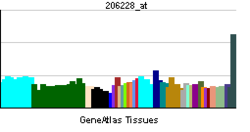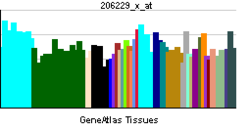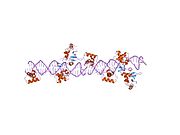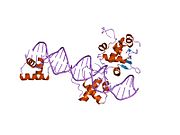- PAX2
-
Paired box gene 2, also known as PAX2 is a protein which in humans is encoded by the PAX2 gene.[1][2]
Contents
Function
PAX2 encodes paired box gene 2, one of many human homologues of the Drosophila melanogaster gene prd. The central feature of this transcription factor gene family is the conserved DNA-binding paired box domain. PAX2 is believed to be a target of transcriptional suppression by the tumor suppressor gene WT1.
Clinical significance
Mutations within PAX2 have been shown to result in optic nerve colobomas and renal hypoplasia. Alternative splicing of this gene results in multiple transcript variants.[3]
Interactions
PAX2 has been shown to interact with PAXIP1.[4]
See also
References
- ^ Pilz AJ, Povey S, Gruss P, Abbott CM (1993). "Mapping of the human homologs of the murine paired-box-containing genes". Mamm. Genome 4 (2): 78–82. doi:10.1007/BF00290430. PMID 8431641.
- ^ Stapleton P, Weith A, Urbánek P, Kozmik Z, Busslinger M (April 1993). "Chromosomal localization of seven PAX genes and cloning of a novel family member, PAX-9". Nat. Genet. 3 (4): 292–8. doi:10.1038/ng0493-292. PMID 7981748.
- ^ "Entrez Gene: PAX2 paired box gene 2". http://www.ncbi.nlm.nih.gov/sites/entrez?Db=gene&Cmd=ShowDetailView&TermToSearch=5076.
- ^ Lechner, M S; Levitan I, Dressler G R (Jul. 2000). "PTIP, a novel BRCT domain-containing protein interacts with Pax2 and is associated with active chromatin". Nucleic Acids Res. (ENGLAND) 28 (14): 2741–51. doi:10.1093/nar/28.14.2741. PMC 102659. PMID 10908331. http://www.pubmedcentral.nih.gov/articlerender.fcgi?tool=pmcentrez&artid=102659.
Data on Xenopus pax2 from Xenbase; [3]
Further reading
- Noll M (1993). "Evolution and role of Pax genes.". Curr. Opin. Genet. Dev. 3 (4): 595–605. doi:10.1016/0959-437X(93)90095-7. PMID 8241771.
- Dahl E, Koseki H, Balling R (1997). "Pax genes and organogenesis.". Bioessays 19 (9): 755–65. doi:10.1002/bies.950190905. PMID 9297966.
- Eccles MR, He S, Legge M, et al. (2003). "PAX genes in development and disease: the role of PAX2 in urogenital tract development.". Int. J. Dev. Biol. 46 (4): 535–44. PMID 12141441.
- Eccles MR, Wallis LJ, Fidler AE, et al. (1992). "Expression of the PAX2 gene in human fetal kidney and Wilms' tumor.". Cell Growth Differ. 3 (5): 279–89. PMID 1378753.
- Sanyanusin P, Schimmenti LA, McNoe LA, et al. (1995). "Mutation of the PAX2 gene in a family with optic nerve colobomas, renal anomalies and vesicoureteral reflux.". Nat. Genet. 9 (4): 358–64. doi:10.1038/ng0495-358. PMID 7795640.
- Ward TA, Nebel A, Reeve AE, Eccles MR (1995). "Alternative messenger RNA forms and open reading frames within an additional conserved region of the human PAX-2 gene.". Cell Growth Differ. 5 (9): 1015–21. PMID 7819127.
- Stapleton P, Weith A, Urbánek P, et al. (1995). "Chromosomal localization of seven PAX genes and cloning of a novel family member, PAX-9.". Nat. Genet. 3 (4): 292–8. doi:10.1038/ng0493-292. PMID 7981748.
- Pilz AJ, Povey S, Gruss P, Abbott CM (1993). "Mapping of the human homologs of the murine paired-box-containing genes.". Mamm. Genome 4 (2): 78–82. doi:10.1007/BF00290430. PMID 8431641.
- Sanyanusin P, McNoe LA, Sullivan MJ, et al. (1996). "Mutation of PAX2 in two siblings with renal-coloboma syndrome.". Hum. Mol. Genet. 4 (11): 2183–4. doi:10.1093/hmg/4.11.2183. PMID 8589702.
- Sanyanusin P, Norrish JH, Ward TA, et al. (1996). "Genomic structure of the human PAX2 gene.". Genomics 35 (1): 258–61. doi:10.1006/geno.1996.0350. PMID 8661132.
- Dehbi M, Ghahremani M, Lechner M, et al. (1996). "The paired-box transcription factor, PAX2, positively modulates expression of the Wilms' tumor suppressor gene (WT1).". Oncogene 13 (3): 447–53. PMID 8760285.
- Bonaldo MF, Lennon G, Soares MB (1997). "Normalization and subtraction: two approaches to facilitate gene discovery.". Genome Res. 6 (9): 791–806. doi:10.1101/gr.6.9.791. PMID 8889548.
- Schimmenti LA, Cunliffe HE, McNoe LA, et al. (1997). "Further delineation of renal-coloboma syndrome in patients with extreme variability of phenotype and identical PAX2 mutations.". Am. J. Hum. Genet. 60 (4): 869–78. PMC 1712484. PMID 9106533. http://www.pubmedcentral.nih.gov/articlerender.fcgi?tool=pmcentrez&artid=1712484.
- Narahara K, Baker E, Ito S, et al. (1997). "Localisation of a 10q breakpoint within the PAX2 gene in a patient with a de novo t(10;13) translocation and optic nerve coloboma-renal disease.". J. Med. Genet. 34 (3): 213–6. doi:10.1136/jmg.34.3.213. PMC 1050895. PMID 9132492. http://www.pubmedcentral.nih.gov/articlerender.fcgi?tool=pmcentrez&artid=1050895.
- Tavassoli K, Rüger W, Horst J (1998). "Alternative splicing in PAX2 generates a new reading frame and an extended conserved coding region at the carboxy terminus.". Hum. Genet. 101 (3): 371–5. doi:10.1007/s004390050644. PMID 9439670.
- Stayner CK, Cunliffe HE, Ward TA, Eccles MR (1998). "Cloning and characterization of the human PAX2 promoter.". J. Biol. Chem. 273 (39): 25472–9. doi:10.1074/jbc.273.39.25472. PMID 9738017.
- Devriendt K, Matthijs G, Van Damme B, et al. (1998). "Missense mutation and hexanucleotide duplication in the PAX2 gene in two unrelated families with renal-coloboma syndrome (MIM 120330).". Hum. Genet. 103 (2): 149–53. doi:10.1007/s004390050798. PMID 9760197.
- Schimmenti LA, Shim HH, Wirtschafter JD, et al. (2000). "Homonucleotide expansion and contraction mutations of PAX2 and inclusion of Chiari 1 malformation as part of renal-coloboma syndrome.". Hum. Mutat. 14 (5): 369–76. doi:10.1002/(SICI)1098-1004(199911)14:5<369::AID-HUMU2>3.0.CO;2-E. PMID 10533062.
PDB gallery External links
This article incorporates text from the United States National Library of Medicine, which is in the public domain.
Transcription factors and intracellular receptors (1) Basic domains (1.1) Basic leucine zipper (bZIP)Activating transcription factor (AATF, 1, 2, 3, 4, 5, 6, 7) · AP-1 (c-Fos, FOSB, FOSL1, FOSL2, JDP2, c-Jun, JUNB, JUND) · BACH (1, 2) · BATF · BLZF1 · C/EBP (α, β, γ, δ, ε, ζ) · CREB (1, 3, L1) · CREM · DBP · DDIT3 · GABPA · HLF · MAF (B, F, G, K) · NFE (2, L1, L2, L3) · NFIL3 · NRL · NRF (1, 2, 3) · XBP1(1.2) Basic helix-loop-helix (bHLH)ATOH1 · AhR · AHRR · ARNT · ASCL1 · BHLHB2 · BMAL (ARNTL, ARNTL2) · CLOCK · EPAS1 · FIGLA · HAND (1, 2) · HES (5, 6) · HEY (1, 2, L) · HES1 · HIF (1A, 3A) · ID (1, 2, 3, 4) · LYL1 · MESP2 · MXD4 · MYCL1 · MYCN · Myogenic regulatory factors (MyoD, Myogenin, MYF5, MYF6) · Neurogenins (1, 2, 3) · NeuroD (1, 2) · NPAS (1, 2, 3) · OLIG (1, 2) · Pho4 · Scleraxis · SIM (1, 2) · TAL (1, 2) · Twist · USF1(1.3) bHLH-ZIP(1.4) NF-1(1.5) RF-X(1.6) Basic helix-span-helix (bHSH)(2) Zinc finger DNA-binding domains (2.1) Nuclear receptor (Cys4)subfamily 1 (Thyroid hormone (α, β), CAR, FXR, LXR (α, β), PPAR (α, β/δ, γ), PXR, RAR (α, β, γ), ROR (α, β, γ), Rev-ErbA (α, β), VDR)
subfamily 2 (COUP-TF (I, II), Ear-2, HNF4 (α, γ), PNR, RXR (α, β, γ), Testicular receptor (2, 4), TLX)
subfamily 3 (Steroid hormone (Androgen, Estrogen (α, β), Glucocorticoid, Mineralocorticoid, Progesterone), Estrogen related (α, β, γ))
subfamily 4 NUR (NGFIB, NOR1, NURR1) · subfamily 5 (LRH-1, SF1) · subfamily 6 (GCNF) · subfamily 0 (DAX1, SHP)(2.2) Other Cys4(2.3) Cys2His2General transcription factors (TFIIA, TFIIB, TFIID, TFIIE (1, 2), TFIIF (1, 2), TFIIH (1, 2, 4, 2I, 3A, 3C1, 3C2))
ATBF1 · BCL (6, 11A, 11B) · CTCF · E4F1 · EGR (1, 2, 3, 4) · ERV3 · GFI1 · GLI-Krüppel family (1, 2, 3, REST, S2, YY1) · HIC (1, 2) · HIVEP (1, 2, 3) · IKZF (1, 2, 3) · ILF (2, 3) · KLF (2, 3, 4, 5, 6, 7, 8, 9, 10, 11, 12, 13, 14, 15, 17) · MTF1 · MYT1 · OSR1 · PRDM9 · SALL (1, 2, 3, 4) · SP (1, 2, 4, 7, 8) · TSHZ3 · WT1 · Zbtb7 (7A, 7B) · ZBTB (16, 17, 20, 32, 33, 40) · zinc finger (3, 7, 9, 10, 19, 22, 24, 33B, 34, 35, 41, 43, 44, 51, 74, 143, 146, 148, 165, 202, 217, 219, 238, 239, 259, 267, 268, 281, 295, 300, 318, 330, 346, 350, 365, 366, 384, 423, 451, 452, 471, 593, 638, 644, 649, 655)(2.4) Cys6(2.5) Alternating composition(3) Helix-turn-helix domains (3.1) HomeodomainARX · CDX (1, 2) · CRX · CUTL1 · DBX (1, 2) · DLX (3, 4, 5) · EMX2 · EN (1, 2) · FHL (1, 2, 3) · HESX1 · HHEX · HLX · Homeobox (A1, A2, A3, A4, A5, A7, A9, A10, A11, A13, B1, B2, B3, B4, B5, B6, B7, B8, B9, B13, C4, C5, C6, C8, C9, C10, C11, C13, D1, D3, D4, D8, D9, D10, D11, D12, D13) · HOPX · IRX (1, 2, 3, 4, 5, 6, MKX) · LMX (1A, 1B) · MEIS (1, 2) · MEOX2 · MNX1 · MSX (1, 2) · NANOG · NKX (2-1, 2-2, 2-3, 2-5, 3-1, 3-2, 6-1, 6-2) · NOBOX · PBX (1, 2, 3) · PHF (1, 3, 6, 8, 10, 16, 17, 20, 21A) · PHOX (2A, 2B) · PITX (1, 2, 3) · POU domain (PIT-1, BRN-3: A, B, C, Octamer transcription factor: 1, 2, 3/4, 6, 7, 11) · OTX (1, 2) · PDX1 · SATB2 · SHOX2 · VAX1 · ZEB (1, 2)(3.2) Paired box(3.3) Fork head / winged helix(3.4) Heat Shock Factors(3.5) Tryptophan clusters(3.6) TEA domain(4) β-Scaffold factors with minor groove contacts (4.1) Rel homology region(4.2) STAT(4.3) p53(4.4) MADS box(4.6) TATA binding proteins(4.7) High-mobility group(4.10) Cold-shock domainCSDA, YBX1(4.11) Runt(0) Other transcription factors (0.2) HMGI(Y)(0.3) Pocket domain(0.6) Miscellaneoussee also transcription factor/coregulator deficiencies
B bsyn: dna (repl, cycl, reco, repr) · tscr (fact, tcrg, nucl, rnat, rept, ptts) · tltn (risu, pttl, nexn) · dnab, rnab/runp · stru (domn, 1°, 2°, 3°, 4°)Categories:- Human proteins
- Transcription factors
- Chromosome 10 gene stubs
Wikimedia Foundation. 2010.





